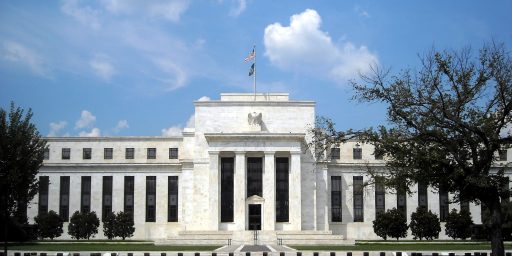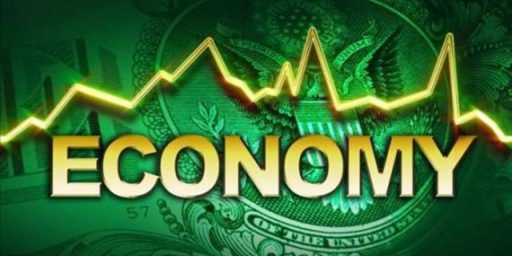Fed Chairman Much Less Powerful in Global Economy
Steven Pearlstein argues, quite persuasively, that the power of the Fed Chairman to shape the economy is much less than popularly believed.
Modern Markets Shatter Model Of Fed Chairman’s Power (WaPo, D1)
In all the hubbub over the appointment of Ben Bernanke to replace the irreplaceable Alan Greenspan, one inconvenient development has been ignored: Thanks to the growing power of global financial markets, the job of Fed chairman ain’t what it used to be.
[…]
In this outdated model, the all-powerful Fed chairman must figure out when, and how much, to tweak the interest-rate dial. In making those judgments, he has relied on elaborate models constructed by the Fed’s research staff that forecasts the future of the economy based on how it has performed before. This fine-tuning assumes an unavoidable trade-off between inflation and unemployment: Reducing one means accepting more of the other.
The past 30 years, however, have not been kind to this Newtonian view of how the economy works. Periods of simultaneous high inflation and high unemployment (late ’70s) or low inflation and low unemployment (late ’90s) raised doubts about the trade-off of the Phillips curve. And the traditional link between money supply and the pace of economic growth began to break down. Structural economic changes — globalization, deregulation, new technology and the shift from manufacturing to services — have confounded the Fed’s forecasts.
But perhaps the biggest change has been that big banks are no longer the main intermediary between savers and borrowers, pricing capital and channeling it to its highest and best use. Instead, complex new financial markets perform those functions more efficiently, using junk bonds and convertible debentures, collateralized debt obligations and other derivatives. A household is more likely to get a loan from a mortgage broker than from a savings bank. A growing company is as likely to get its capital from a private equity fund, mezzanine lender, venture capitalist or hedge fund as from a commercial bank. And the source of all this capital is as likely to be the central bank of China as a rich retiree in Palm Beach.
As a result of those changes, the Fed increasingly finds itself not leading markets but rushing to catch up with them. And it explains the “conundrum” of the Fed moving short rates one way while long rates move in the opposite direction. In terms of the federal funds rate, it now takes bigger changes over longer periods to have the desired effect on the economy. It also means that the Fed’s main impact on the economy is not direct, through the “pumping” process, but indirect, through its powers of persuasion and regulation.
Exactly. Of course, those “powers of persuasion and regulation” are not insignificant. Greenspan’s pronouncements on the economy, which often went far afield from his actual responsibilities, sent shudders throught the world financial markets. But governments are simply less able to shape the economy than people seem to believe. Presidents don’t have job creation wands and Fed chairs can’t magically stop the business cycle.



